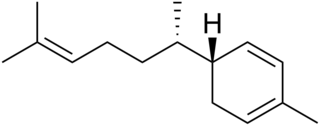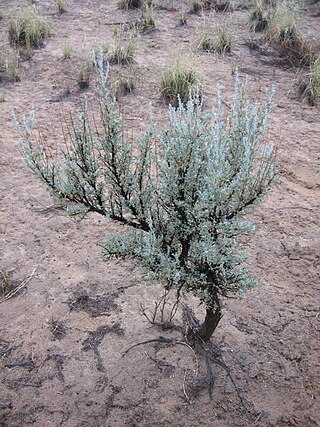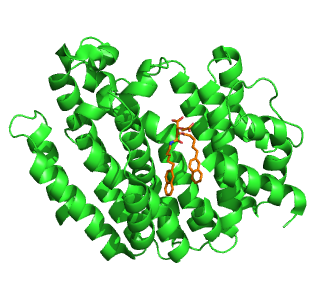The terpenoids, also known as isoprenoids, are a class of naturally occurring organic chemicals derived from the 5-carbon compound isoprene and its derivatives called terpenes, diterpenes, etc. While sometimes used interchangeably with "terpenes", terpenoids contain additional functional groups, usually containing oxygen. When combined with the hydrocarbon terpenes, terpenoids comprise about 80,000 compounds. They are the largest class of plant secondary metabolites, representing about 60% of known natural products. Many terpenoids have substantial pharmacological bioactivity and are therefore of interest to medicinal chemists.

Terpenes are a class of natural products consisting of compounds with the formula (C5H8)n for n ≥ 2. Terpenes are major biosynthetic building blocks. Comprising more than 30,000 compounds, these unsaturated hydrocarbons are produced predominantly by plants, particularly conifers. In plants, terpenes and terpenoids are important mediators of ecological interactions, while some insects use some terpenes as a form of defense. Other functions of terpenoids include cell growth modulation and plant elongation, light harvesting and photoprotection, and membrane permeability and fluidity control.

Kavalactones are a class of lactone compounds found in kava roots and Alpinia zerumbet. Some kavalactones are bioactive.

Ginkgolides are biologically active terpenic lactones present in Ginkgo biloba. They are diterpenoids with 20-carbon skeletons, which are biosynthesized from geranylgeranyl pyrophosphate.

Zingiberene is a monocyclic sesquiterpene that is the predominant constituent of the oil of ginger, from which it gets its name. It can contribute up to 30% of the essential oils in ginger rhizomes. This is the compound that gives ginger its distinct flavoring.

Sesquiterpenes are a class of terpenes that consist of three isoprene units and often have the molecular formula C15H24. Like monoterpenes, sesquiterpenes may be cyclic or contain rings, including many unique combinations. Biochemical modifications such as oxidation or rearrangement produce the related sesquiterpenoids. A recent study conducted in the Cosmics Leaving Outdoor Droplets large cloud chamber at CERN, has identified sesquiterpenes—gaseous hydrocarbons that are released by plants—as potentially playing a major role in cloud formation in relatively pristine regions of the atmosphere.

Triterpenes are a class of terpenes composed of six isoprene units with the molecular formula C30H48; they may also be thought of as consisting of three terpene units. Animals, plants and fungi all produce triterpenes, including squalene, the precursor to all steroids.

Squalene synthase (SQS) or farnesyl-diphosphate:farnesyl-diphosphate farnesyl transferase is an enzyme localized to the membrane of the endoplasmic reticulum. SQS participates in the isoprenoid biosynthetic pathway, catalyzing a two-step reaction in which two identical molecules of farnesyl pyrophosphate (FPP) are converted into squalene, with the consumption of NADPH. Catalysis by SQS is the first committed step in sterol synthesis, since the squalene produced is converted exclusively into various sterols, such as cholesterol, via a complex, multi-step pathway. SQS belongs to squalene/phytoene synthase family of proteins.
GABA receptor antagonists are drugs that inhibit the action of GABA. In general these drugs produce stimulant and convulsant effects, and are mainly used for counteracting overdoses of sedative drugs.
In enzymology, a geranyltranstransferase is an enzyme that catalyzes the chemical reaction

Geranylgeranyl pyrophosphate synthase is an enzyme that in humans is encoded by the GGPS1 gene.

Zaragozic acids are a family of natural products produced by fungi. The first characterized zaragozic acids, A, B, and C were isolated from an unidentified sterile fungal culture, Sporormiella intermedia, and L. elatius, respectively. just outside the European city Zaragoza, Spain on the Jalón river. This family of natural products possesses a unique 4,8-dioxabicyclo[3.2.1]octane core, and vary in their 1-alkyl and their 6-acyl side chains.

Damascenones are a series of closely related chemical compounds that are components of a variety of essential oils. The damascenones belong to a family of chemicals known as rose ketones, which also includes damascones and ionones. beta-Damascenone is a major contributor to the aroma of roses, despite its very low concentration, and is an important fragrance chemical used in perfumery.

Carotol was first isolated by scientists Asahina and Tsukamoto in 1925. It is one of the primary components found in carrot seed oil comprising approximately 40% of this essential oil. This sesquiterpene alcohol is thought to be formed in carrot seeds during the vegetation period. Additionally, studies have shown that carotol may be involved in allelopathic interactions expressing activity as an antifungal, herbicidal and insecticidal agent.

Absinthin is a naturally produced triterpene lactone from the plant Artemisia absinthium (Wormwood). It constitutes one of the most bitter chemical agents responsible for absinthe's distinct taste. The compound shows biological activity and has shown promise as an anti-inflammatory agent, and should not be confused with thujone, a neurotoxin also found in Artemisia absinthium.

(+)-Costunolide is a naturally occurring sesquiterpene lactone, first isolated in Saussurea costus roots in 1960. It is also found in lettuce.
5-Epiaristolochene synthase is an enzyme with systematic name (2E,6E)-farnesyl-diphosphate diphosphate-lyase ( -5-epiaristolochene-forming). This enzyme catalyses the following chemical reaction
Cynaropicrin is a sesquiterpene lactone of the guaianolide type found mainly in leaves of artichoke plants. It is one of the compounds that gives the artichoke its characteristic bitterness. It is found in artichoke leaves with an abundance of approximately 87 g/kg, but can hardly be found in other parts of the plant. Cynaropicrin makes up about 0.7% of leaf extracts of the artichoke. It exhibits a large diversity of bioactivities and shows properties such as anti-inflammatory, antifeedant and activation of bitter sensory receptors, but has not yet been used in medicine. Despite its pharmacologically beneficial properties, it can be toxic in higher doses. The compound has attracted attention in recent years as a potential anticancer drug.

Arglabin is a sesquiterpene lactone belonging to the guaianolide subclass bearing a 5,7,5-tricyclic ring system which is known to inhibit farnesyl transferase. It is characterized by an epoxide on the cycloheptane as well as an exocyclic methylene group that is conjugated with the carbonyl of the lactone. Arglabin is extracted from Artemisia glabella, a species of wormwood, found in the Karaganda Region of Kazakhstan. Arglabin and its derivatives are biologically active and demonstrate promising antitumor activity and cytoxocity against varying tumor cell lines.

In organic chemistry, a guaianolide is a type of sesquiterpene lactone consisting of a gamma-lactone and either a cyclopentane or cyclopentene, both fused to a central cycloheptane or cycloheptene structure. There are two subclasses, structural isomers differing in the location that part of the lactone is bonded to the central ring, known as 6,12-guaianolides and 8,12-guaianolides.
















